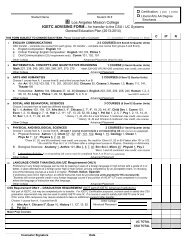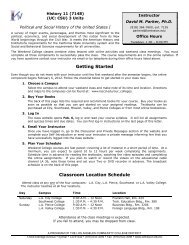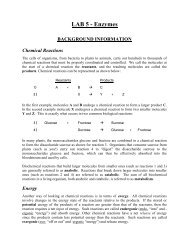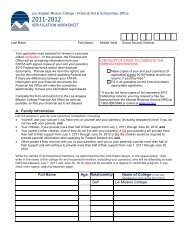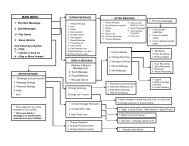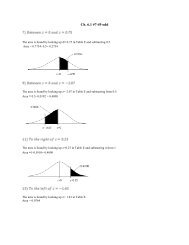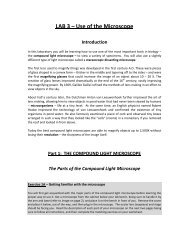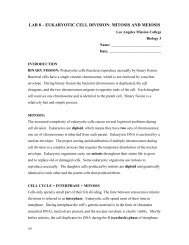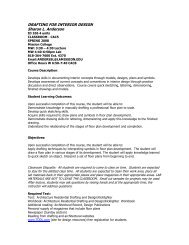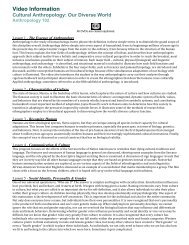Chapter 8: Mitosis - Cell Division and Reproduction
Chapter 8: Mitosis - Cell Division and Reproduction
Chapter 8: Mitosis - Cell Division and Reproduction
Create successful ePaper yourself
Turn your PDF publications into a flip-book with our unique Google optimized e-Paper software.
<strong>Chapter</strong> 8:<br />
The <strong>Cell</strong>ular Basis of <strong>Reproduction</strong> <strong>and</strong><br />
Inheritance
Introduction<br />
Stages of an Organism’s Life Cycle:<br />
Development: All changes that occur from a<br />
fertilized egg or an initial cell to an adult<br />
organism.<br />
<strong>Reproduction</strong>: Production of offspring that<br />
carry genetic information in the form of<br />
DNA, from their parents.<br />
Two types of reproduction:<br />
1. Sexual <strong>Reproduction</strong><br />
2. Asexual <strong>Reproduction</strong>
Types of reproduction:<br />
1. Sexual <strong>Reproduction</strong>:<br />
Most common type of animal reproduction.<br />
Male <strong>and</strong> female gametes or sex cells (sperm <strong>and</strong> egg<br />
cell) join together to create a fertilized egg or zygote.<br />
The offspring has genetic information from both parents.<br />
Offspring are genetically different from each parents<br />
<strong>and</strong> their siblings.<br />
Advantages:<br />
Ensures genetic diversity of offspring.<br />
• Population more likely to survive changing environment.<br />
Disadvantages:<br />
Cannot reproduce without a partner of opposite sex.<br />
Considerable time, energy, <strong>and</strong> resources spent to find a suitable<br />
mate.<br />
Parents only pass on 1/2 (50%) of their genetic information to<br />
each offspring.
2. Asexual <strong>Reproduction</strong>:<br />
Production of offspring by a single parent through:<br />
<br />
<br />
<br />
<br />
Splitting: Binary fission in bacteria.<br />
Budding: Yeasts, plants<br />
Fragmentation: Sea stars<br />
Parthenogenesis: “Virgin birth”. Several insect species.<br />
Offspring inherit DNA form one parent only.<br />
Offspring are genetically identical to parent <strong>and</strong> siblings,<br />
unless mutations occur.<br />
Advantages:<br />
Can reproduce without a partner of opposite sex.<br />
Don’t spend time, energy, <strong>and</strong> resources to find a suitable mate.<br />
Parents pass on 100% of their genetic information to each<br />
offspring.<br />
Disadvantage:<br />
No genetic diversity of offspring.<br />
• Population less likely to survive changing environment.
<strong>Cell</strong>s Only Arise from Preexisting <strong>Cell</strong>s<br />
New cells are made through cell division:<br />
• Unicellular organisms (Bacteria, protozoa):<br />
<strong>Division</strong> of one cell into two new organisms through<br />
binary fission or mitosis.<br />
• Multicellular organisms (Plants, animals):<br />
If sexual reproduction:<br />
1. Growth <strong>and</strong> development from zygote or fertilized egg.<br />
Original cell divides by mitosis to produce many cells,<br />
that are genetically identical to first cell.<br />
<strong>Cell</strong>s later develop specific functions (differentiation).<br />
2. <strong>Reproduction</strong> requires:<br />
Meiosis: Special type of cell division that will generate<br />
gametes or sex cells, with 50% of individual’s genetic<br />
material.
Bacteria (Procarytoes) Reproduce Asexually by<br />
Binary Fission<br />
Features of Bacterial DNA<br />
Single, relatively small circular chromosome:<br />
About 3-5 million nucleotide base pairs<br />
Contains only about 5-10,000 genes<br />
Binary fission<br />
Single circular DNA is replicated<br />
Bacterium grows to twice normal size<br />
<strong>Cell</strong> divides into two daughter cells<br />
Each daughter cell with an identical copy of DNA<br />
Rapid process, as little as 20 minutes.
Bacteria Reproduce Asexually by Binary Fission
Eucaryotic cell division is a more complex <strong>and</strong> time<br />
consuming process than binary fission<br />
Features of Eucaryotic DNA<br />
1. DNA is in multiple linear chromosomes.<br />
Unique number for each species:<br />
• Humans have 46 chromosomes.<br />
• Cabbage has 20, mosquito 6, <strong>and</strong> fern over 1000.<br />
2. Large Genome: Up to 3 billion base pairs (humans)<br />
Contains up to 50,000-150,000 genes<br />
Human genome project is determining the sequence of entire<br />
human DNA.<br />
3. DNA is enclosed by nuclear membrane.<br />
Correct distribution of multiple chromosomes in each<br />
daughter cell requires a much more elaborate process<br />
than binary fission.
Human Body <strong>Cell</strong>s Have 46 Chromosomes
DNA: Found as Chromosomes or Chromatin<br />
Chromosomes<br />
Chromatin<br />
Tightly packaged DNA Unwound DNA<br />
Found only during cell Found throughout cell<br />
division<br />
cycle<br />
DNA is not being used DNA is being used<br />
for macromolecule for macromolecule<br />
synthesis.<br />
synthesis.
Eucaryotic Chromosomes Duplicate Before<br />
Each <strong>Cell</strong> <strong>Division</strong>
<strong>Cell</strong> Cycle of Eucaryotic <strong>Cell</strong>s<br />
Sequence of events from the time a cell is formed,<br />
until the cell divides once again.<br />
Before cell division, the cell must:<br />
Precisely copy genetic material (DNA)<br />
Roughly double its cytoplasm<br />
Synthesize organelles, membranes, proteins, <strong>and</strong> other<br />
molecules.<br />
<strong>Cell</strong> cycle is divided into two main phases:<br />
Interphase: Stage between cell divisions<br />
Mitotic Phase: Stage when cell is dividing
Eucaryotic <strong>Cell</strong> Cycle:<br />
Interphase + Mitotic Phase
The Life Cycle of a Eucaryotic <strong>Cell</strong>:<br />
Interphase: Time between cell divisions.<br />
Most cells spend about 90% of their time in interphase.<br />
<strong>Cell</strong>s actively synthesize materials they need to grow.<br />
Chromosomes are duplicated.<br />
Interphase can be divided into three stages:<br />
1. G 1 phase: Just after cell division.<br />
<strong>Cell</strong> grows in size, increases number of organelles, <strong>and</strong><br />
makes proteins needed for DNA synthesis.<br />
2. S phase: DNA replication.<br />
Single chromosomes are duplicated so they contain two<br />
sister chromatids.<br />
3. G 2 phase: Just before cell division.<br />
Protein synthesis increases in preparation for cell division.
Duplication of Chromosomes During S<br />
stage of Interphase<br />
DNA replication during<br />
S stage of Interphase<br />
Single chromosome<br />
Two identical sister<br />
chromatids joined by<br />
a centromere ( )
The Life Cycle of a Eucaryotic <strong>Cell</strong>:<br />
<strong>Mitosis</strong>: The process of eucaryotic cell division.<br />
Most cells spend less than 10% of time in mitosis.<br />
<strong>Mitosis</strong> is divided into four stages:<br />
1. Prophase: <strong>Cell</strong> prepares for division.<br />
2. Metaphase: Chromosomes line up in “middle” of cell.<br />
3. Anaphase: Sister chromatids split <strong>and</strong> migrate to<br />
opposite sides of the cell.<br />
4. Telophase: DNA is equally divided into two new<br />
daughter cells. Cytokinesis usually occurs.<br />
Cytokinesis: <strong>Division</strong> of cytoplasm.<br />
Mitotic Phase: <strong>Mitosis</strong> + Cytokinesis
Mitotic Phase: <strong>Mitosis</strong> + Cytokinesis
<strong>Mitosis</strong>: The Stages of <strong>Cell</strong> <strong>Division</strong><br />
1. Prophase<br />
Chromatin condenses into chromosomes, which appear<br />
as two sister chromatids joined by a centromere.<br />
Nucleoli disappear.<br />
Nuclear envelope breaks apart.<br />
In animal cells, mitotic spindle begins to form as<br />
mictotubules grow out of two centrosomes or<br />
microtubule organizing centers (MTOCs).<br />
• Each centrosome is made up of a pair of centrioles.<br />
Microtubules attach to kinetochores on chromatids <strong>and</strong><br />
begin to move chromosomes towards center of cell.<br />
Centrosomes begin migrating to opposite poles of cell.
Interphase <strong>and</strong> Prophase of <strong>Mitosis</strong> in Animal <strong>Cell</strong>
<strong>Mitosis</strong>: The Stages of <strong>Cell</strong> <strong>Division</strong><br />
2. Metaphase<br />
Short period in which chromosomes line up along<br />
equatorial plane of cell (metaphase plate).<br />
Chromosomes are completely condensed <strong>and</strong> easy to<br />
visualize.<br />
Mitotic spindle is fully formed.<br />
Kinetochores of sister chromatids face opposite sides<br />
<strong>and</strong> are attached to spindle microtubules at opposite<br />
ends of the cell.
Metaphase, Anaphase, <strong>and</strong> Telophase of<br />
<strong>Mitosis</strong> in an Animal <strong>Cell</strong>
<strong>Mitosis</strong>: The Stages of <strong>Cell</strong> <strong>Division</strong><br />
3.Anaphase<br />
Centromeres of sister chromatids begin to separate.<br />
Each chromatid is now an independent daughter<br />
chromosome.<br />
The separate chromosomes are pulled toward opposite<br />
ends by spindle microtubules, attached to the<br />
kinetochores.<br />
<strong>Cell</strong> elongates as poles move farther apart.<br />
Anaphase ends when a complete set of chromosomes<br />
reaches each pole.
<strong>Mitosis</strong>: The Stages of <strong>Cell</strong> <strong>Division</strong><br />
4. Telophase<br />
<strong>Cell</strong> continues to elongate.<br />
<strong>Cell</strong> returns to interphase conditions:<br />
• A nuclear envelope forms around each set of<br />
chromosomes.<br />
• Chromosomes uncoil, becoming chromatin threads.<br />
• Nucleoli reappear.<br />
• Spindle microtubules disappear.<br />
Cytokinesis usually occurs at the end of this stage
Mitotic Phase: <strong>Mitosis</strong> + Cytokinesis<br />
Cytokinesis<br />
The division of cytoplasm to produce two daughter<br />
cells. Usually begins during telophase.<br />
• In animal cells: <strong>Division</strong> is accomplished by a<br />
cleavage furrow that encircles the cell like a ring in<br />
the equator region.<br />
• In plant cells: <strong>Division</strong> is accomplished by the<br />
formation of a cell plate between the daughter cells.<br />
Each cell produces a plasma membrane <strong>and</strong> a cell<br />
wall on its side of the plate.
Cytokinesis in Animal <strong>and</strong> Plant <strong>Cell</strong>s<br />
Animal <strong>Cell</strong><br />
Plant <strong>Cell</strong>
External Factors Control <strong>Mitosis</strong><br />
1. Anchorage<br />
Most cells cannot divide unless they are attached<br />
to a solid surface.<br />
May prevent inappropriate growth of detached cells<br />
2. Nutrients <strong>and</strong> growth factors<br />
Lack of nutrients can limit mitosis<br />
Growth factors: Proteins that stimulate cell<br />
division.<br />
3. <strong>Cell</strong> density<br />
Density-dependent inhibition: Cultured cells will<br />
stop dividing after a single layer covers the petri<br />
dish. <strong>Mitosis</strong> is inhibited by high cell density.<br />
Cancer cells do not demonstrate density inhibition
Density Dependent Inhibition of <strong>Mitosis</strong><br />
Normal <strong>Cell</strong>s Stop Dividing at High <strong>Cell</strong> Density<br />
Cancer <strong>Cell</strong>s are Not Inhibited by High <strong>Cell</strong> Density
<strong>Cell</strong>-Cycle Control System<br />
There are three critical points at which the cell<br />
cycle is controlled*:<br />
1. G1 Checkpoint: Prevents cell from entering S<br />
phase <strong>and</strong> duplicating DNA.<br />
Most important checkpoint.<br />
Amitotic cells (muscle <strong>and</strong> nerve cells) are frozen here.<br />
2. G2 Checkpoint: Prevents cell from entering<br />
mitosis.<br />
3. M Checkpoint: Prevents cell from entering<br />
cytokinesis.<br />
*<strong>Cell</strong>s must have proper growth factors to get<br />
through each checkpoint.
<strong>Cell</strong> <strong>Division</strong> is Controlled at Three Key Stages<br />
Growth factors are<br />
required to pass<br />
each checkpoint
Cancer is a Disease of the <strong>Cell</strong> Cycle<br />
Cancer kills 1 in 5 people in the United States.<br />
Cancer cells divide excessively <strong>and</strong> invade other<br />
body tissues.<br />
Tumor: Abnormal mass of cells that originates<br />
from uncontrolled mitosis of a single cell.<br />
Benign tumor: Cancer cells remain in original site.<br />
Can easily be removed or treated<br />
Malignant tumor: Cancer cells have ability to “detach”<br />
from tumor <strong>and</strong> spread to other organs or tissues<br />
Metastasis: Spread of cancer cells form site of origin to<br />
another organ or tissue.<br />
Tumor cells travel through blood vessels or lymph nodes.
Metastasis: Cancer <strong>Cell</strong>s Spread<br />
Throughout Body
Functions of <strong>Mitosis</strong> in Eucaryotes:<br />
1. Growth: All somatic cells that originate after a<br />
new individual is created are made by mitosis.<br />
2. <strong>Cell</strong> replacement: <strong>Cell</strong>s that are damaged or<br />
destroyed due to disease or injury are replaced<br />
through mitosis.<br />
3. Asexual <strong>Reproduction</strong>: <strong>Mitosis</strong> is used by<br />
organisms that reproduce asexually to make<br />
offspring.
<strong>Mitosis</strong> Replaces Dead Skin <strong>Cell</strong>s
Chromosomes are matched in homologous pairs<br />
Homologous Chromosomes:<br />
Eucaryotic chromosomes come in pairs.<br />
Normal humans have 46 chromosomes in 23 pairs.<br />
One chromosome of each pair comes from an<br />
individual’s mother, the other comes from the father.<br />
Homologous chromosomes carry genes that control the<br />
same characteristics.<br />
Examples: Eye color, blood type, flower color, or height<br />
Locus: Physical site on a chromosomes where a given<br />
gene is located.<br />
Allele: Different forms of the same gene.<br />
Example: Alleles for blood types A, B, or O.
Homologous Pair of Chromosomes:<br />
One Comes From Each Parent
Homologous Chromosomes: Code for the Same Genetic<br />
Traits, but Have Different Alleles
There are two types of chromosomes:<br />
1. Autosomes: Found in both males <strong>and</strong> females.<br />
<br />
<br />
In humans there are 22 pairs of autosomes.<br />
Autosomes are of the same size <strong>and</strong> are homologous.<br />
2. Sex Chromosomes: Determine an individual’s gender.<br />
<br />
One pair of chromosomes (X <strong>and</strong> Y).<br />
The X <strong>and</strong> Y chromosomes are not homologous.<br />
The X chromosome is much larger than the Y chromosome <strong>and</strong><br />
contains many genes.<br />
The Y chromosome has a small number of genes.<br />
<br />
In Humans <strong>and</strong> other mammals females are XX <strong>and</strong><br />
males are XY.
Chromosomes of Normal Human Male:<br />
44 (22 Pairs) Autosomes + XY
Normal Genetic Complement of Humans:<br />
Females: 44 autosomes (22 pairs) + XX<br />
Males: 44 autosomes (22 pairs) + XY<br />
Note: In most cases, having additional or missing<br />
chromosomes is usually fatal or causes serious defects.<br />
Down’s syndrome: Trisomy 21. Individual’s with an extra<br />
chromosome 21. Most common chromosomal defect (1 in<br />
700 births in U.S.). Mental retardation, mongoloid facial<br />
features, heart defects, etc.
Gametes have a single set of chromosomes<br />
Humans have two sets of chromosomes, one<br />
inherited from each parent.<br />
• Diploid <strong>Cell</strong>s: <strong>Cell</strong>s whose nuclei contain two<br />
homologous sets of chromosomes (2n).<br />
Somatic cells are diploid (almost all cells in our body).<br />
In humans the diploid number (2n) is 46.<br />
• Haploid <strong>Cell</strong>s: <strong>Cell</strong>s whose nuclei contain a single<br />
set of chromosomes (n).<br />
Gametes are haploid (egg <strong>and</strong> sperm cells).<br />
In humans the haploid number (n) is 23.<br />
Fertilization: Haploid egg fuses with a haploid<br />
sperm to form a diploid zygote (fertilized egg).
Meiosis Produces Haploid Gametes From Diploid Parents<br />
Fertilization Produces Diploid Offspring from Haploid Gametes
<strong>Mitosis</strong> versus Meiosis<br />
<strong>Mitosis</strong><br />
Meiosis<br />
One cell division<br />
Two successive cell divisions<br />
Produces two (2) cells Produces four (4) cells<br />
Produces diploid cells Produces haploid gametes<br />
Daughter cells are genetically<br />
identical to mother cell<br />
No crossing over<br />
Functions: Growth,<br />
cell replacement, <strong>and</strong><br />
asexual reproduction<br />
<strong>Cell</strong>s are genetically different from<br />
mother cell <strong>and</strong> each other<br />
Crossing over*<br />
Functions: Sexual reproduction<br />
*Crossing over: Exchange of DNA between homologous chromosomes.
Meiosis: Generates haploid gametes<br />
• Reduces the number of chromosomes by half,<br />
producing haploid cells from diploid cells.<br />
• Also produces genetic variability, each gamete is<br />
different, ensuring that two offspring from the<br />
same parents are never identical.<br />
• Two divisions: Meiosis I <strong>and</strong> meiosis II.<br />
Chromosomes are duplicated in interphase prior<br />
to Meiosis I.<br />
Meiosis I: Separates the members of each homologous<br />
pair of chromosomes. Reductive division.<br />
Meiosis II: Separates chromatids into individual<br />
chromosomes.
STAGES OF MEIOSIS<br />
Interphase:<br />
Chromosomes<br />
replicate<br />
Meiosis I:<br />
Reductive division.<br />
Homologous<br />
chromosomes separate<br />
Meiosis II:<br />
Sister chromatids<br />
separate
Meiosis I: Separation of Homologous Chromosomes<br />
1. Prophase I:<br />
Most complex phase of meiosis (90% of time)<br />
Chromatin condenses into chromosomes.<br />
Nuclear membrane <strong>and</strong> nucleoli disappear.<br />
Centrosomes move to opposite poles of cell <strong>and</strong><br />
microtubules attach to chromatids.<br />
Synapsis: Homologous chromosomes pair up<br />
<strong>and</strong> form a tetrad of 4 sister chromatids.<br />
Crossing over: DNA is exchanged between<br />
homologous chromosomes, resulting in genetic<br />
recombination. Unique to meiosis.<br />
Chiasmata: Sites of DNA exchange.
Prophase I: Crossing Over Between<br />
Homologous Chromosomes
Meiosis I: Separation of Homologous<br />
Chromosomes<br />
2. Metaphase I:<br />
Chromosome tetrads (homologous<br />
chromosomes) line up in the middle of the cell.<br />
Each homologous chromosome faces opposite<br />
poles of the cell.
Meiosis I: Homologous Chromosomes<br />
Separate
Stages of Meiosis: Meiosis I<br />
3. Anaphase I:<br />
Chromosome tetrads split up.<br />
Homologous chromosomes of each pair separate,<br />
moving towards opposite poles.<br />
R<strong>and</strong>om assortment: One chromosome from each<br />
homologous pair is shuffled into the two daughter<br />
cells, r<strong>and</strong>omly <strong>and</strong> independently of the other pairs.<br />
R<strong>and</strong>om assortment increases genetic diversity of<br />
offspring. Possible combinations: 2 n .<br />
One human cell can generate 2 23 or over 8.3 million<br />
different gametes by r<strong>and</strong>om assortment alone.
R<strong>and</strong>om Assortment of Homologous Chromosomes<br />
During Meiosis I Generates Many Possible Gametes
Meiosis I: Separation of Homologous<br />
Chromosomes<br />
4. Telophase I <strong>and</strong> Cytokinesis:<br />
Chromosomes reach opposite poles of the cell.<br />
Nucleoli reorganize, chromosomes uncoil, <strong>and</strong><br />
cytokinesis occurs.<br />
New cells are haploid.
Meiosis II: Separation of Sister Chromatids<br />
During interphase that follows meiosis I, no DNA<br />
replication occurs.<br />
Interphase may be very brief or absent.<br />
Meiosis II is very similar to mitosis.<br />
1. Prophase II:<br />
Very brief, chromosomes reform.<br />
No crossing over or synapsis.<br />
Spindle forms <strong>and</strong> starts to move chromosomes<br />
towards center of the cell.
Meiosis II: Separation of Sister Chromatids<br />
2. Metaphase II:<br />
Very brief, individual chromosomes line up in<br />
the middle of the cell.<br />
Kinetochores of chromatids face opposite<br />
poles.<br />
3. Anaphase II:<br />
Chromatids separate <strong>and</strong> move towards<br />
opposite ends of the cell.
Meiosis II: Separation of Sister Chromatids
Meiosis II: Separation of Sister Chromatids<br />
4. Telophase II:<br />
Nuclei form at opposite ends of the cell.<br />
Cytokinesis occurs.<br />
Product of meiosis:<br />
Four (4) haploid gametes, each genetically<br />
different from the other.
Meiosis Produces Four Genetically Different Gametes
Meiosis in Males <strong>and</strong> Females<br />
Spermatogenesis:<br />
Four sperm cells are made.<br />
Starts in puberty <strong>and</strong> occurs continuously.<br />
Males produce millions of sperm cells a month.<br />
Oogenesis:<br />
Only one large egg is produced. The other three<br />
cells are small polar bodies.<br />
Oogenesis starts before birth in females, stops at<br />
Prophase I, <strong>and</strong> resumes during puberty.<br />
Meiosis is completed only after fertilization.<br />
Females make one mature egg/month.
<strong>Mitosis</strong> versus Meiosis (Review)<br />
<strong>Mitosis</strong><br />
Meiosis<br />
One cell division<br />
Two successive cell divisions<br />
Produces two (2) cells Produces four (4) cells<br />
Produces diploid cells Produces haploid gametes<br />
Daughter cells are genetically<br />
identical to mother cell<br />
No crossing over<br />
Functions: Growth,<br />
cell replacement, <strong>and</strong><br />
asexual reproduction<br />
<strong>Cell</strong>s are genetically different from<br />
mother cell <strong>and</strong> each other<br />
Crossing over*<br />
Functions: Sexual reproduction<br />
*Crossing over: Exchange of DNA between homologous chromosomes.
Crossing Over in Meiosis Increases Genetic Diversity
Sources of Genetic Variability in<br />
Sexual <strong>Reproduction</strong><br />
1. Crossing Over: After crossing over <strong>and</strong> synapsis,<br />
sister chromatids are no longer identical.<br />
2. Independent Assortment: Each human can<br />
produce over 8.3 million different gametes by<br />
r<strong>and</strong>om shuffling of chromosomes in meiosis I.<br />
3. Fertilization: A couple can produce over 64<br />
trillion (8.3 million x 8.3 million) different zygotes<br />
during fertilization. This figure does not take into<br />
account diversity created by crossing over.
Accidents During Meiosis Can Cause<br />
Chromosomal Abnormalities<br />
Nondisjunction: Chromosomes fail to separate.<br />
Members of a pair of homologous chromosomes fail to<br />
separate during meiosis I or:<br />
Sister chromatids fail to separate during meiosis II.<br />
Nondisjunction increases with age.<br />
Gametes (<strong>and</strong> zygotes) will have an extra<br />
chromosome, others will be missing a chromosome.<br />
Trisomy: Individuals with one extra chromosome, three<br />
instead of pair. Have 47 chromosomes in cells.<br />
Monosomy: Missing a chromosome, one instead of pair.<br />
Have 45 chromosomes in cells.
Nondisjunction of Chromosomes During<br />
Meiosis Produces Abnormal Gametes
Accidents During Meiosis Can Result<br />
in a Trisomy or Monosomy<br />
Most abnormalities in numbers of autosomes are<br />
very serious or fatal.<br />
Down’s syndrome: Caused by a trisomy of<br />
chromosome number 21 (1 in 700 births). Mental<br />
retardation, mongoloid features, <strong>and</strong> heart defects.<br />
Most abnormalities of sex chromosomes do not<br />
affect survival.<br />
Klinefelter Syndrome: Males with an extra sex<br />
chromosome (XXY) (1 in 1000 male births).<br />
Turner Syndrome: Females missing one sex<br />
chromosome (XO) (1 in 2500 female births).
Down’s Syndrome is More Common in<br />
Children Born to Older Mothers
Abnormal Numbers of Sex Chromosomes<br />
Usually Do Not Affect Survival<br />
Klinefelter Syndrome (XXY) Turner Syndrome (XO)<br />
Incidence: 1:1000 male births Incidence: 1 in 2500 female births



